keaton pehrson
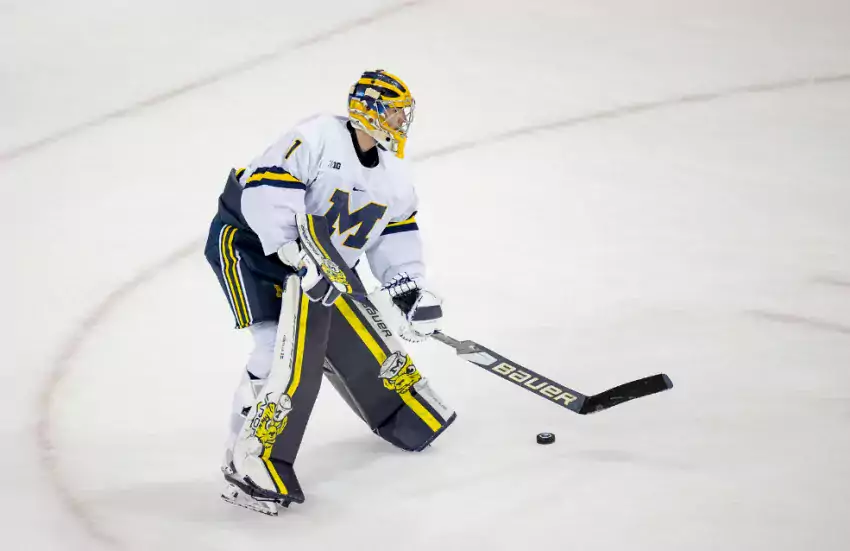
Michigan's goalie search is officially on, as the Ontario Reign, the AHL affiliate of the Los Angeles Kings, announced they've signed Portillo to an ATO contract.
We've signed @umichhockey goaltender Erik Portillo to an ATO! Welcome aboard the #ReignTrain, @ErikPortillo20!
— X - Ontario Reign (@ontarioreign) April 10, 2023
An ATO stands for amateur tryout agreement, but in practice it means Portillo is going pro but agreed not to count this year towards his entry-level clock. He'll be getting his feet wet in the AHL over the remainder the season, and is almost certain to sign an entry-level deal when it's over. (I'll explain further below). Portillo was drafted in his 18-year-old season by Buffalo, who traded his rights last month to the Kings. LA will keep him on an entry-level contract through the 2025-'26 campaign.
Michigan will also lose a trio of seniors who provided some much-needed experience on the back end of this year's team. Gritty Nick Granowicz centered the checking line, and has a COVID season left to play. He scored 36 points in 101 games for Michigan in the last four years, but participated in senior night, and was expected to move on. Ciccolini might be a bigger surprise; the forechecking winger lost a big chunk of the middle of his Michigan career to injury—including the entire 2021-'22 season—but was a drafted player (7th rounder in 2019) and had a few streaks where he was able to convince us he was about to finally break out.
Blueliner Keaton Pehrson was also a senior, and a steady presence over four seasons when it seemed every other defenseman on the roster was getting injured just so Pehrson could stay on the top defensive pairing. Over the years #20 was often the other guy out there with Cam York, Owen Power, or Luke Hughes. His presence there couldn't by justified by a scoresheet, but Pehrson was the epitome of a guy who does his work off the puck. His final year was his best, with 11 assists, and four crucial blocks in the banner-clinching win at Minnesota in the Big Ten Tournament. He never did develop his on-the-puck game.
While the skaters are making room for youth, Michigan will definitely be a player in the goalie portal now, since backup (who came to be a backup) Noah West is also in the portal, and freshman Tyler Shea is an overager who only dressed for three games this year. Brown goalie Mathieu Caron seems like the one and only target for now; the rising junior put up a 2.49 GAA and 92.1 save percentage for a terrible ECAC team. No other goalie in the portal looks plausible, though you never know who else might pry loose.
Putting Portillo's Michigan career in context is difficult since we're still in the shadow of its nadir. Backing up Strauss Mann as a freshman, Portillo put up numbers equal to the elder star. As a blue-chip prospect, it was understood that the massive Portillo would inherit the job in 2021-'22, and Mann duly departed for a pro career. Michigan had virtually no drop-off, as Portillo was one of the best goalies in the country as a sophomore. He was expected to take another step forward as a junior, but it didn't work out that way. He made some incredible stops, had some great games, and enjoyed coming out of his net to play the puck even more than his fans hated when he did that. He also began making crude mistakes, taking awhile to get back up after going to the ice, losing his poise, losing his stick, and most egregiously losing the Frozen Four semifinal after giving up two bank shots and sharp-angle softy.
Part of the problem might have been that Portillo was working without a goalie coach—Steve Shields left the program after his complaints triggered the investigation that brought down Mel Pearson, and the volunteer assistant who replaced Shields took another opportunity in the middle of this season. It's hard not to see a correlation between the coaching situation and Portillo's fundamental breakdowns. It's also hard not to see the giant Swede developing into a fine NHL goalie in a few years.
Why does an amateur deal mean he's gone?
The current collective bargaining agreement between the NHL and its players union keeps entry-level salaries locked to prescribed maximums for their draft positions for (usually) three years. The clock doesn't start until they're out of college, but college hockey ends weeks before the NHL/AHL regular seasons, and sometimes players get signed and spend those last few weeks as professionals, burning through one of their entry-level years in the process. In general teams want to keep their draftees on entry-level contracts, and players want to get past that, so when you see a Matty Berniers jump to the NHL immediately it often means his team is willing to give up an entry-level year to entice him to come.
On the flipside, for a guy who isn't ready for the NHL however, the added franchise value of being on an entry-level contract can be a good thing, since the team that owns his rights can afford to be patient with his development, and might favor a cheap asset who's under team control. However if the player gets all the way through his senior year in college, the team that drafted him actually loses his rights. Portillo was a junior, but could have played one more season and become a free agent. This was the impetus for the team that drafted Portillo in the 3rd round, the Buffalo Sabres, to trade his rights to Los Angeles. At that point we figured Portillo was gone, because teams don't usually acquire those rights unless they're confident they will sign him and he'll forego his senior year.
Signing the ATO and joining Ontario means he intends to sign with LA next year, but also wants to play out the end of the AHL season without having it count as an entry-level season. Even though it literally says "amateur" in the title, signing an ATO is considered signing with a pro team by the NCAA's definition, so Portillo's collegiate eligibility is over.
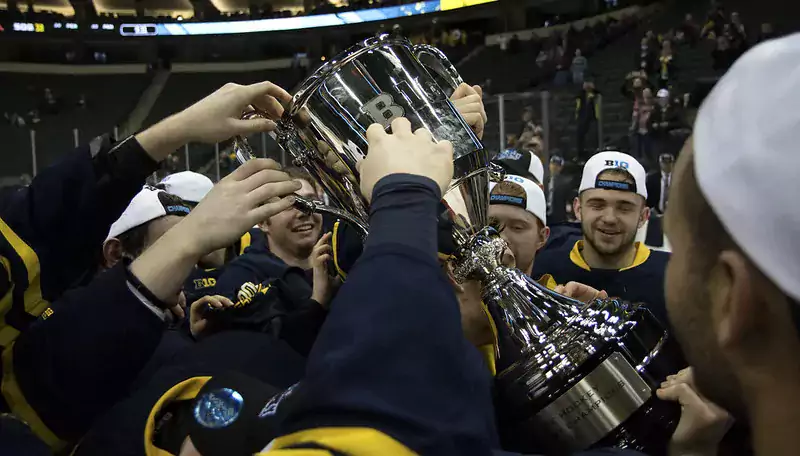
CLICK HERE for Game Recap from Kristy McNeil and other pertinent information and HERE for current Pairwise Rankings.
What just happened (TL;DR): Michigan just won the Big Ten Hockey Tournament in Minneapolis for the second straight season! They responded well being down a goal twice, including once in the third period. AND…they killed off a game, holding a one goal lead for the final 8+ minutes. All very impressive feats that they’ve struggled with throughout the year. #EyeballEmoji
FINAL CORSI NUMBERS (www.collegehockeynews.com)
|
|
Total Attempts |
Even Strength |
Power Play |
Close (within 1) |
Even Strength % |
|
Minnesota |
53 |
48 |
5 |
40 |
45% |
|
Michigan |
64 |
59 |
5 |
50 |
55% |
Forward Notes.
-After a back and forth boring first period, Michigan mostly dominated possession and shots for the rest of the game. While they did makes mistakes to give up a number of transitional chances, Michigan rolled their lines and were able to sustain zone time and create looks on net with basically every line contributing. Minnesota’s superstar top line did get their chances, but Michigan’s depth (h/t Alex) proved strong throughout the game.
-Rutger McGroarty tallied Michigan’s first two goals on similar chances. The first came on a rebound that Ethan Edwards threw on net. The rebound kicked to Rutger in the slot and he buried it. The second was a bomb from Keaton Pehrson off the end boards out in front. Again, Rutger was positioned well in front the of the net for the rebound dunk. He also provided the screen on the game-tying goal.
-I mentioned that this rink/game/team was never going to fit Dylan Duke’s strong suit. He’s never going to be as effective in an Olympic rink. For the most part, that was true. BUT…in the third period, in a tie game, Dylan Duke made a play. TJ Hughes made a great entry pass from the blue line right to Duke’s stick. Dylan went forehand, backhand around Justen Close’s out-stretched skate and finished inside the post for the game-winner. Right where you’d expect Duke to finish.
-The fourth line was impressive on Saturday night. Mark Estapa was great on the forecheck, winning pucks below the goalline. He also had a number of decent scoring chances, too, including ringing the iron on the penalty kill. Nolan Moyle, too, had a few decent chances and checked well on both ends. Nick Granowicz also made a really nice play backchecking in his own crease to breakup a very good look.

Seamus Casey had the game-tying goal (Patrick Barron)
Defense Notes.
-In zone, Michigan’s defense was pretty good. They didn’t get overwhelmed and trapped very often. There weren’t TOO many bad DZTOs. They generally were comfortable on the puck getting it up and out. Luke Hughes and Keaton Pehrson had a bit of a rough start. Luke also did have a couple turnovers he’d probably want back, but overall it was a pretty positive night.
-The defensive issues came in transition. Luke Hughes made a bad shot decision that lead to a 2v1. Keaton Pehson played it very poorly, allowing a simple pass across for a goal. Seamus Casey was also caught napping once that lead to a rush. Casey and Edwards were both caught in the offensive zone when Minnesota scored on their 2v0. Steve Holtz was completely undressed by Rhett Pitlick on a 1v1 for the third goal. Holtz is by all accounts a great dude with a phenomenal recovery story, but he’s probably not skating in an ideal defensive lineup for Michigan. A lot of the positives Michigan gained with the play in their own end, they gave away in transition.
-Despite getting burned on a couple of very bad OMRs, Seamus Casey did snipe a corner from distance to tie the game in the third period. It was his 7th goal of the season and his 24th point in his 33rd game. Not bad.
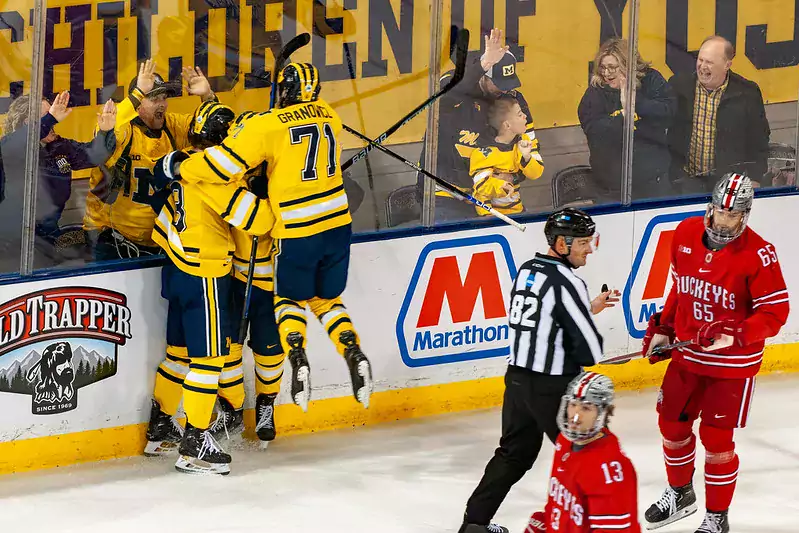
3/11/2023 – Michigan 7, Ohio State 3 – 23-11-3 (9-7-3-5 B1G)
In the first game of the second half of the season, Michigan played Ohio State at Yost and got plastered. The Buckeyes throttled Michigan in a way that no team that no team in the past half-decade has, completely overwhelming the Wolverines and crushing them with shot after shot directed on Erik Portillo. Michigan actually scored the first goal of the game and went into intermission tied, but the shots on goal for the period were 23-7 Ohio State. In the second, OSU scored five times, two at 5v5, two on the PP, and one shorthanded. The shots on goal in that period were 22-9. Through forty minutes, the Buckeyes led by four and were on pace for 68 shots on goal. They backed off in the third with a commanding lead but still tacked on one more goal. For the game, shot attempts were 79-49 for the Scarlet and Gray. It was the kind of performance Michigan puts up against a bottom feeder like Lindenwood, not something that happens to Michigan, a top 5-10 team in the country wire-to-wire this year.
The overriding thought after that game among Michigan Hockey observers was "what the hell just happened?". As I wrote after the weekend, Michigan had gotten put in a pressure cooker. Ohio State ran a hyper aggressive offensive zone forecheck, all three forwards deep in the zone either pressuring the puck or providing support on any potential rims, with the defensemen hard pinching at the point/down the walls to keep it going. Against a Michigan team with lighter defensemen who prefer to skate the puck out of the zone and play with it on their stick, Ohio State had a matchup advantage by taking away time and space to do so. They forced Michigan's defensemen to make decisions in a split second and wanted to make them play a way they are unfamiliar with, quick passing and chips up the boards vs. controlled possession breakouts by one guy.
The Wolverines came back the next night after that first meeting and generally handled it better, but they were still wobbly, allowing a goal right off the jump that was very similar to the goals they were allowing in buckets the night before, with a defenseman turning it over under pressure. When the teams met again in Columbus, Michigan put up a similar performance to game #2, handling it alright, but still seeing the ice tilted against them in a shootout loss. During the wacky outdoor game in Cleveland, Michigan handled OSU better than they had all season for the first 30-35 minutes, playing a very even game, but things spiraled and a series of mistakes (mostly on special teams!) let it get away from 'em.
I described Ohio State in the preview last week as a "riddle (Michigan) has struggled to solve", but the reality is that Michigan had slowly been putting together the pieces to solve that riddle. With each passing game against the Bucks, Brandon Naurato's team was becoming more familiar, more comfortable with playing the kind of game that you need to break down Ohio State's system and open the floodgates open. We saw that in the outdoor game, but much of the analysis from it was obscured by the goofiness of an outdoor game, the poor ice conditions, strange camera angles, and then the team's ultimate meltdown in the third period. Under the surface, the clues were there. This weekend the Michigan team pulled out their magnifying glass, pipe, trench coat, and sluethin' hat and solved the damn riddle.
[AFTER THE JUMP: Clips of team growth]
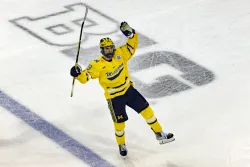
Just like football.
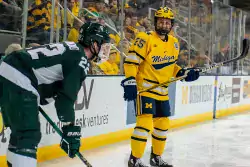
Basically Friday night's game without the goofy Portillo goals and with a Dylan Duke finish.
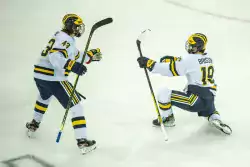
Finally...
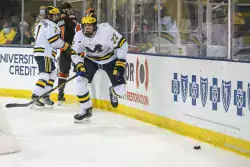
Some more roster breakdown, everyone's favorite kind of preview content.
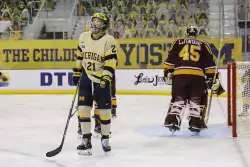
Hockey Weekly is back from a break and wishes it had better games to talk about.
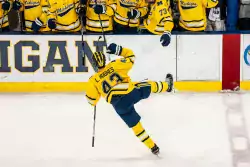
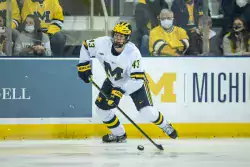
13